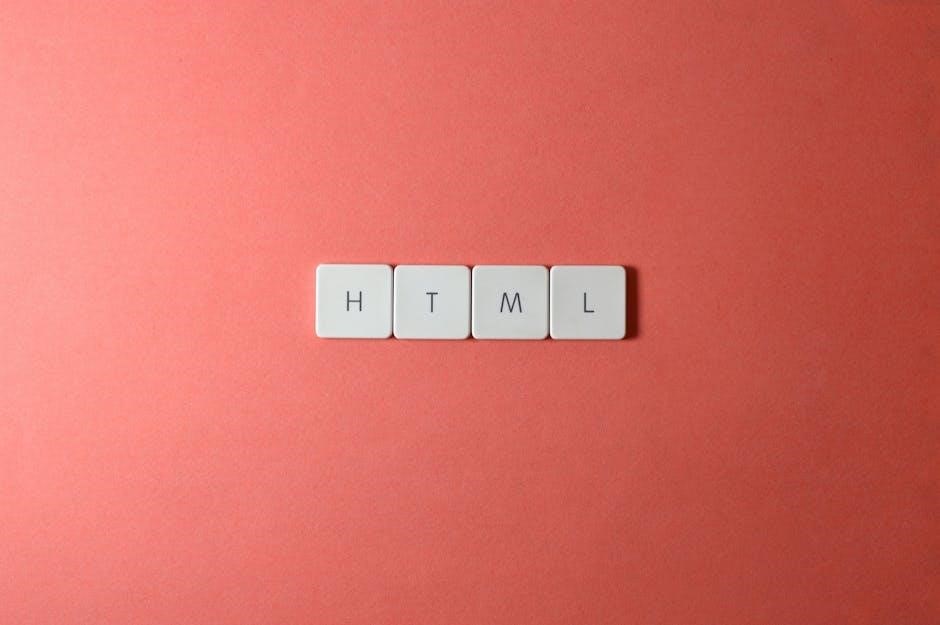
pdfsharp html to pdf
1.1 Overview of PDFSharp as a .NET PDF Library
PdfSharp is a popular open-source .NET library for creating, reading, and modifying PDF documents. It offers a lightweight and flexible solution for generating PDFs programmatically, ideal for developers seeking simplicity and efficiency in PDF creation without the need for external dependencies. While it doesn’t natively support HTML-to-PDF conversion, it pairs well with complementary libraries like HtmlRenderer.PdfSharp to extend its functionality. Its intuitive API and cross-platform compatibility make it a preferred choice for .NET developers.
1.2 Importance of Converting HTML to PDF
Converting HTML to PDF combines the flexibility of HTML with the portability of PDFs, ensuring consistent formatting and offline accessibility. It’s essential for generating reports, invoices, and preserving web content accurately.

Getting Started with HtmlRenderer.PdfSharp
HtmlRenderer.PdfSharp is a powerful library that extends PdfSharp’s capabilities, enabling HTML-to-PDF conversion. To begin, ensure your project targets a compatible .NET framework version, such as .NET Framework 4.6.1 or later. Install the TheArtOfDev.HtmlRenderer.PdfSharp NuGet package, which simplifies the process of rendering HTML content into PDF documents. Once installed, you can use its intuitive API to convert HTML strings or files into PDFs seamlessly. The library supports basic HTML structures and styling, making it ideal for generating reports, invoices, or web page snapshots. For complex HTML layouts, HtmlRenderer.PdfSharp provides options to handle tables, images, and CSS styles effectively. By leveraging this library, developers can streamline their HTML-to-PDF conversion tasks while maintaining high-quality output.
2.1 Installing the Required NuGet Packages
To use HtmlRenderer.PdfSharp, install the TheArtOfDev.HtmlRenderer.PdfSharp NuGet package. This can be done via the NuGet Package Manager or by running the appropriate .NET CLI command.

Converting HTML to PDF with HtmlRenderer.PdfSharp
HtmlRenderer.PdfSharp simplifies converting HTML content to PDF documents by leveraging the PdfSharp library. It allows developers to render HTML snippets or full web pages into PDF files with minimal code. To achieve this, you can use the `PdfGenerator.GeneratePdf` method, which accepts HTML content, page size, and margins. The library supports basic HTML structures, including text, images, and tables, making it suitable for generating reports, invoices, and other documents.
The conversion process is straightforward: provide the HTML content, configure settings like page orientation and margins, and generate the PDF. This approach ensures consistent and high-quality PDF output while maintaining the layout and styling of the original HTML.
Example code demonstrates how to convert a simple HTML string to a PDF file using HtmlRenderer.PdfSharp, showcasing its ease of use and flexibility for various applications.
Overall, HtmlRenderer.PdfSharp is a reliable solution for HTML-to-PDF conversion in .NET applications, offering robust functionality and seamless integration with PdfSharp.
3.2 Handling Complex HTML Structures
HtmlRenderer.PdfSharp effectively handles complex HTML structures, including nested tables, CSS styles, and multi-page content. It ensures accurate rendering of intricate layouts, tables, and div elements, maintaining visual fidelity in the PDF output.

Advanced Features and Customization
HtmlRenderer.PdfSharp offers advanced features for customizing PDF output, enabling developers to tailor documents to specific needs. Key capabilities include support for custom CSS styles, allowing precise control over fonts, colors, and layouts. The library also supports headers, footers, and page numbering, which can be dynamically generated based on document content. Additionally, it allows for the execution of JavaScript within HTML content, enabling interactive elements and dynamic data manipulation during conversion. Developers can customize margins, page sizes, and orientation to ensure consistency across generated PDFs. These features make it ideal for creating professional-quality documents with complex formatting requirements. By leveraging these advanced options, users can achieve highly customized and polished PDF outputs, making HtmlRenderer.PdfSharp a versatile tool for various PDF generation scenarios.
4.1 Styling and CSS Support in PDF Generation

HtmlRenderer.PdfSharp provides robust support for CSS styling, ensuring that HTML content is accurately converted to PDF while maintaining its visual appeal. Developers can apply custom CSS styles to control fonts, colors, margins, and other layout properties, preserving the integrity of the original HTML design. The library supports both inline and external CSS stylesheets, allowing for flexible styling options. Additionally, it handles complex CSS features like borders, padding, and positioning, enabling precise control over the PDF output. This capability is particularly useful for generating professional-quality documents that match the appearance of their web-based counterparts. By leveraging CSS support, developers can ensure consistency in branding and layout, making HtmlRenderer.PdfSharp an excellent choice for creating visually appealing PDFs from HTML content.
4.2 Adding Headers, Footers, and Page Numbers

HtmlRenderer.PdfSharp allows adding headers, footers, and page numbers via CSS, using @page and counter properties, enabling precise control over placement and formatting for professional PDF documents.

Best Practices for High-Quality PDF Generation

Generating high-quality PDFs from HTML requires careful preparation and optimization. Start by ensuring your HTML content is clean, well-structured, and free of errors. Use semantic HTML tags to improve rendering accuracy. Avoid inline styles and rely on external CSS for consistent styling. Test your HTML across different browsers to ensure compatibility. When using libraries like HtmlRenderer.PdfSharp, leverage their CSS support to maintain layout integrity. Minimize the use of external resources and ensure all images and fonts are properly embedded. Optimize images to balance quality and file size. Use appropriate page sizes and margins to match your PDF requirements; Finally, test the PDF output in different viewers to ensure consistency. By following these practices, you can achieve professional-grade PDFs that meet your needs.
5.1 Optimizing HTML Content for PDF Conversion
Ensure HTML is clean and well-structured with semantic tags. Use external CSS for consistent styling and avoid inline styles. Minimize external resources and optimize images for better PDF output quality.

Comparing HtmlRenderer.PdfSharp with Other Libraries
HtmlRenderer.PdfSharp stands out as a reliable solution for HTML-to-PDF conversion in .NET, especially when combined with PDFSharp. Unlike NReco, it is free and integrates seamlessly with PDFSharp, making it a cost-effective choice for developers. iTextSharp, while powerful, often requires a commercial license for advanced features, which may not be ideal for open-source projects; IronPDF, though robust, is a paid library and may not suit budget-conscious developers. HtmlRenderer.PdfSharp excels in handling complex HTML structures and CSS, offering flexibility for custom layouts. Its lightweight nature and ease of use make it a preferred option for generating reports or invoices. While it may lack some advanced features of paid libraries, its simplicity and compatibility with PDFSharp ensure high-quality PDF generation. For developers seeking a free, efficient, and intuitive HTML-to-PDF solution, HtmlRenderer.PdfSharp remains a top choice.
6.1 NReco vs. HtmlRenderer.PdfSharp
NReco and HtmlRenderer.PdfSharp are two popular libraries for HTML-to-PDF conversion in .NET, each with unique strengths. NReco, a wrapper for wkhtmltopdf, is renowned for its high-fidelity HTML and CSS rendering, making it ideal for complex layouts and modern web content. However, it requires wkhtmltopdf to be installed on the server, which can complicate deployment. HtmlRenderer.PdfSharp, built on top of PDFSharp, offers a lightweight, dependency-free solution, perfect for seamless integration with .NET projects. While it may not match NReco’s advanced rendering capabilities, it excels in simplicity and ease of use. NReco is better suited for enterprise-level applications requiring precise control over PDF output, whereas HtmlRenderer.PdfSharp is a cost-effective, straightforward choice for developers seeking efficient HTML-to-PDF conversion without external dependencies.

